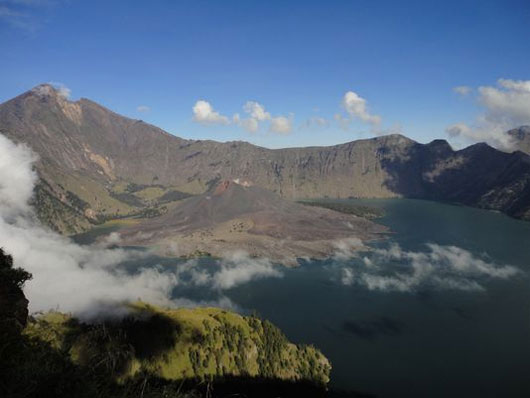Decode the mysterious volcanic eruption in the 13th century
Scientists have said the mysterious cryptanalysis of the volcano caused a horrific eruption in the 13th century.
The event happened in 1257 with the massive eruption, so that its ash is still present in ice as far away as the Arctic and Antarctica.
While medieval texts in Europe recorded sudden cold climates and crop failures.
The BBC on September 30 leads the latest research published in PNAS (Proceedings of the National Academy of Sciences), saying that a group of international experts identified the location of the disaster as Samalas volcano on the island. Lombok in Indonesia.
Currently, Samalas volcano remains only a large lake of the original crater.

Samalas Crater in Indonesia, today is a large lake - (Photo: IPGP)
The results came after the team made a comparison of the chemical properties of the ash of the eruption in 1257, which remained in the polar ice sheet and data collected in the Lombok region, as well. like understanding the chronicle in the Kingdom of Lombok during the 13th century.
"The evidence is very solid and convincing , " Professor Clive Oppenheimer, of the University of Cambridge (UK), told the BBC.
His colleague Professor Franck Lavigne, of the Pantheon-Sorbonne University (France) added, "We do the work almost like a criminal investigation."
The BBC said the volcanic disaster of 1257 in earlier reports was thought to have originated in volcanoes in Mexico, Ecuador or New Zealand.
However, through geochemical studies, volcanoes in these countries are unresponsive and only Samalas may be suitable to "fill in all the blanks" , the researchers said.
According to a new study, the Samalas volcano, when erupted in 1257, has thrown into the space of ashes with a mass of up to 40 km, and the column of ashes flew to an altitude of at least 40km and covered the planet, reaching Europe. Europe and leave ruins in polar ice sheets .
This outbreak has a strong impact on the global climate, making the weather worse with cold weather, rain constantly causing floods and causing great damage to crops.
- Mysterious decoding 10,000 13th century skeletons in London
- Volcanic eruption in the Philippines, 5 people died
- Video: Japan's largest volcano
- Volcanic eruption in Indonesia, 6,000 people evacuated
- This is the cause of the largest volcanic eruption in history
- Video: Volcanic eruption creates 9,000 m high smoke column in Japan
- The most brilliant volcanic eruption in the solar system
- Hawaiian volcano erupted with precious stones, Hawaiian people were eager to pick up
- Volcanic eruption in Indonesia, 7 people died
- Volcanic eruptions create new islands
- The scene of the terrible volcanic eruption in Guatemala
- Lava crickets: Legendary animals appear only after volcanic eruptions, the grass has just disappeared
 Is the magnetic North Pole shift dangerous to humanity?
Is the magnetic North Pole shift dangerous to humanity? Washington legalizes the recycling of human bodies into fertilizer
Washington legalizes the recycling of human bodies into fertilizer Lightning stone - the mysterious guest
Lightning stone - the mysterious guest Stunned by the mysterious sunset, strange appearance
Stunned by the mysterious sunset, strange appearance